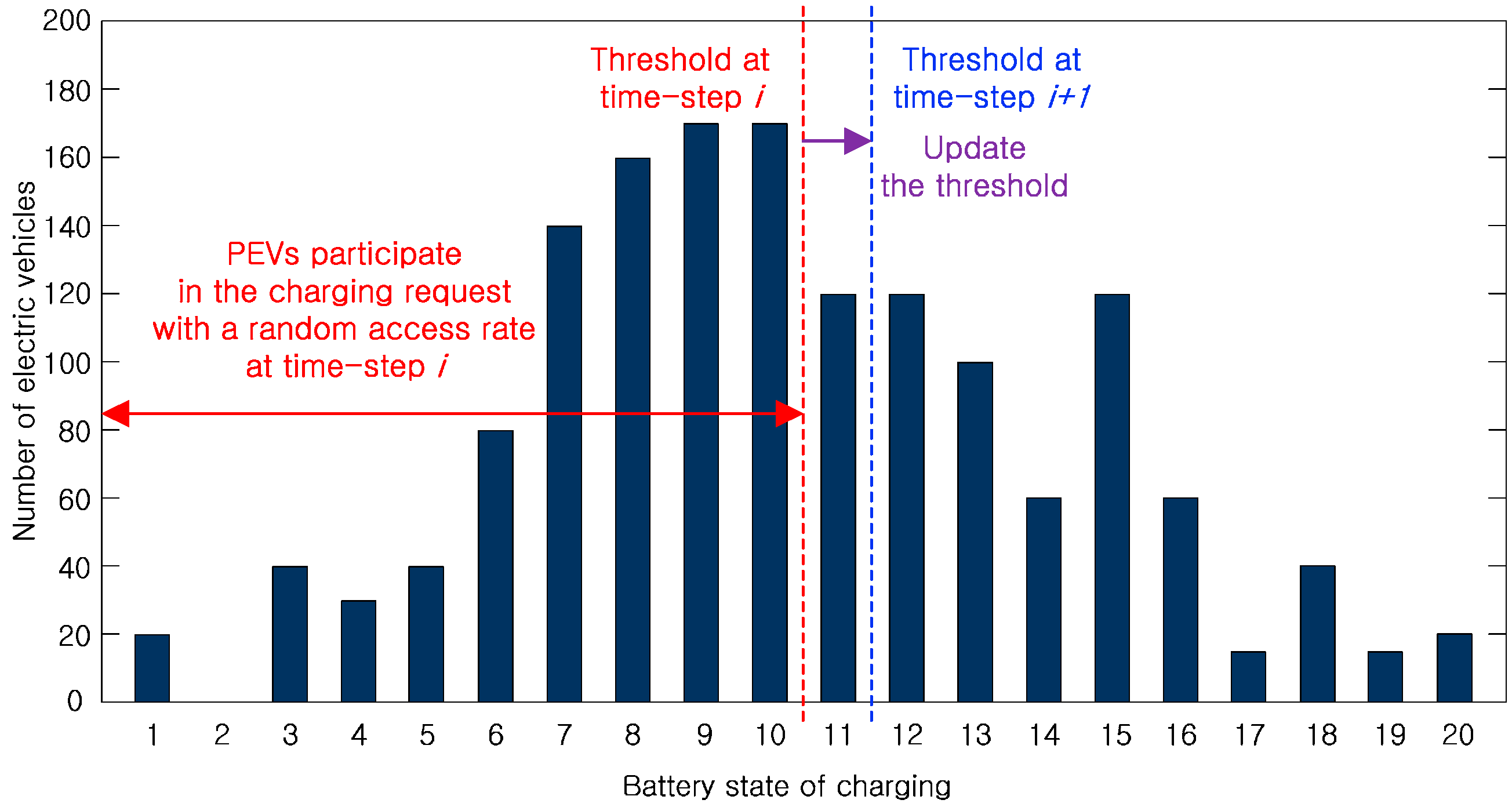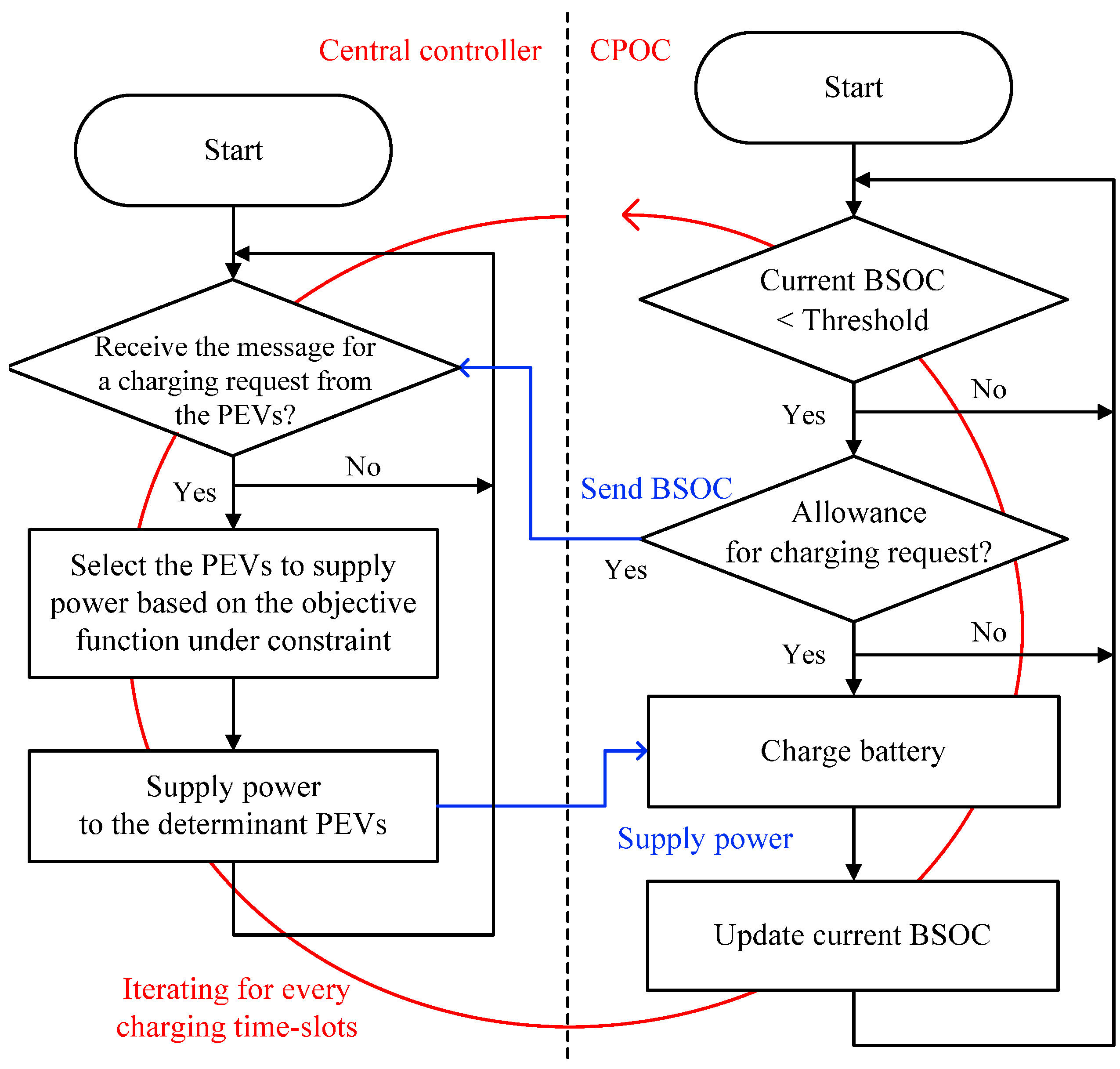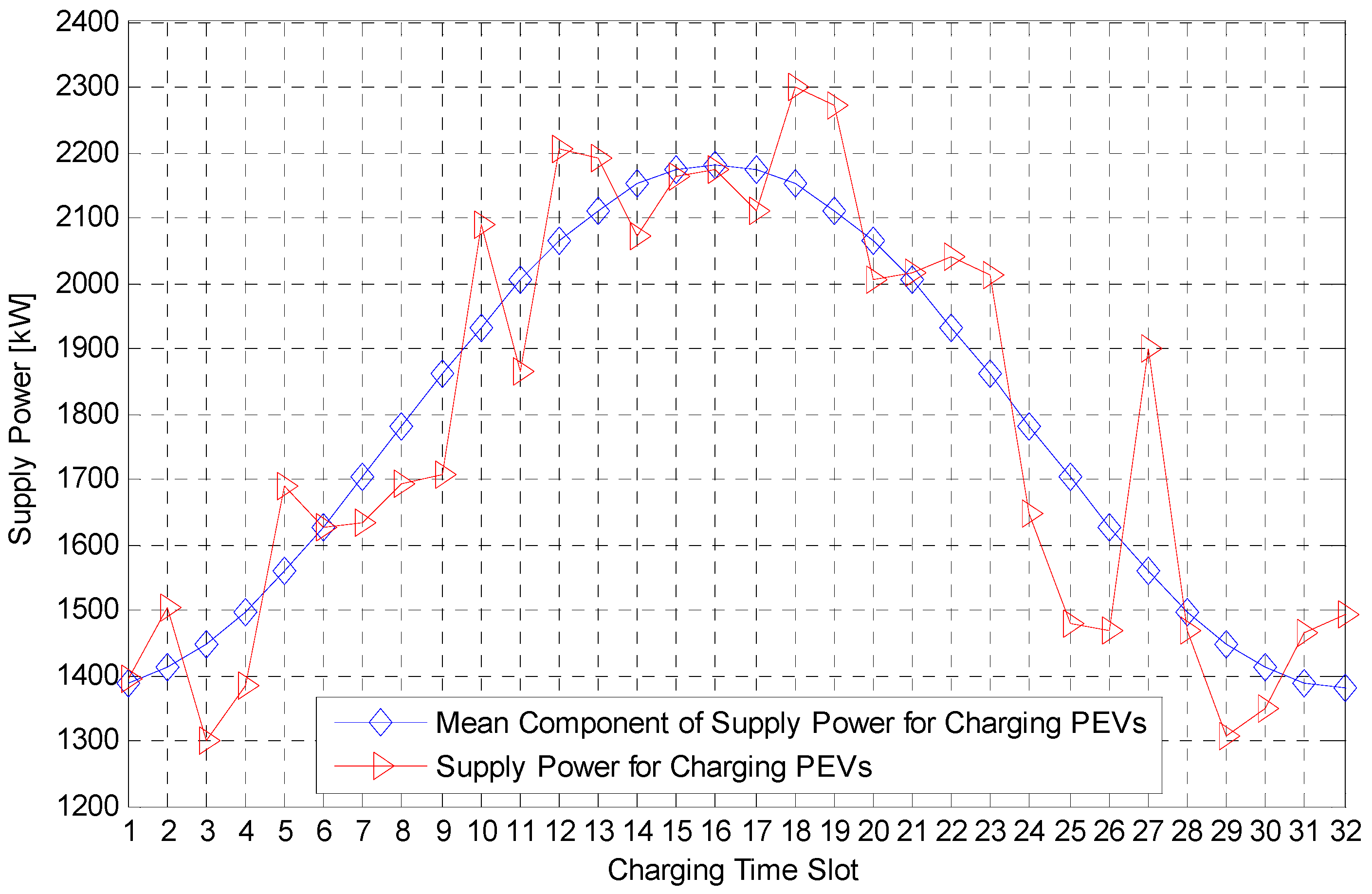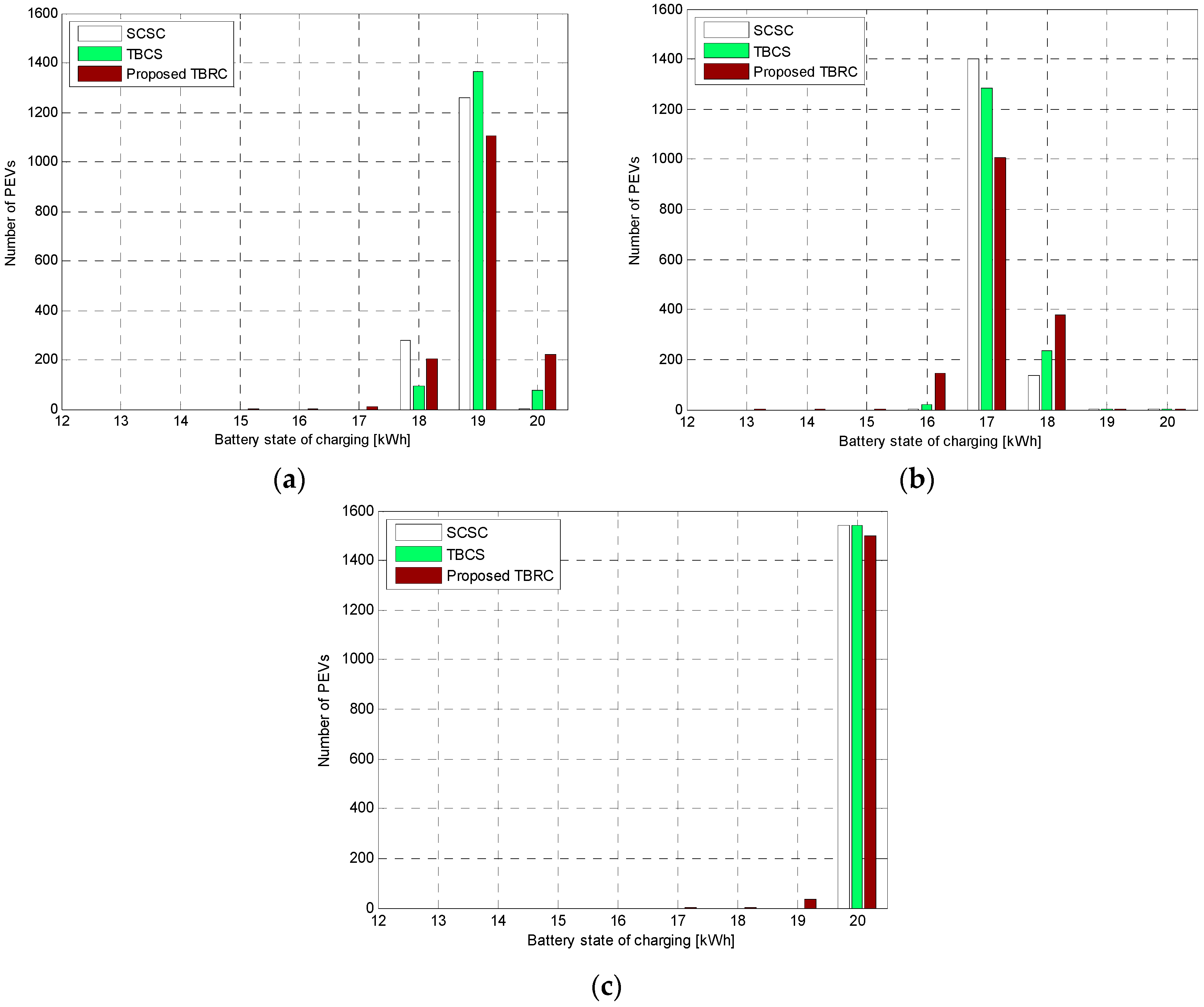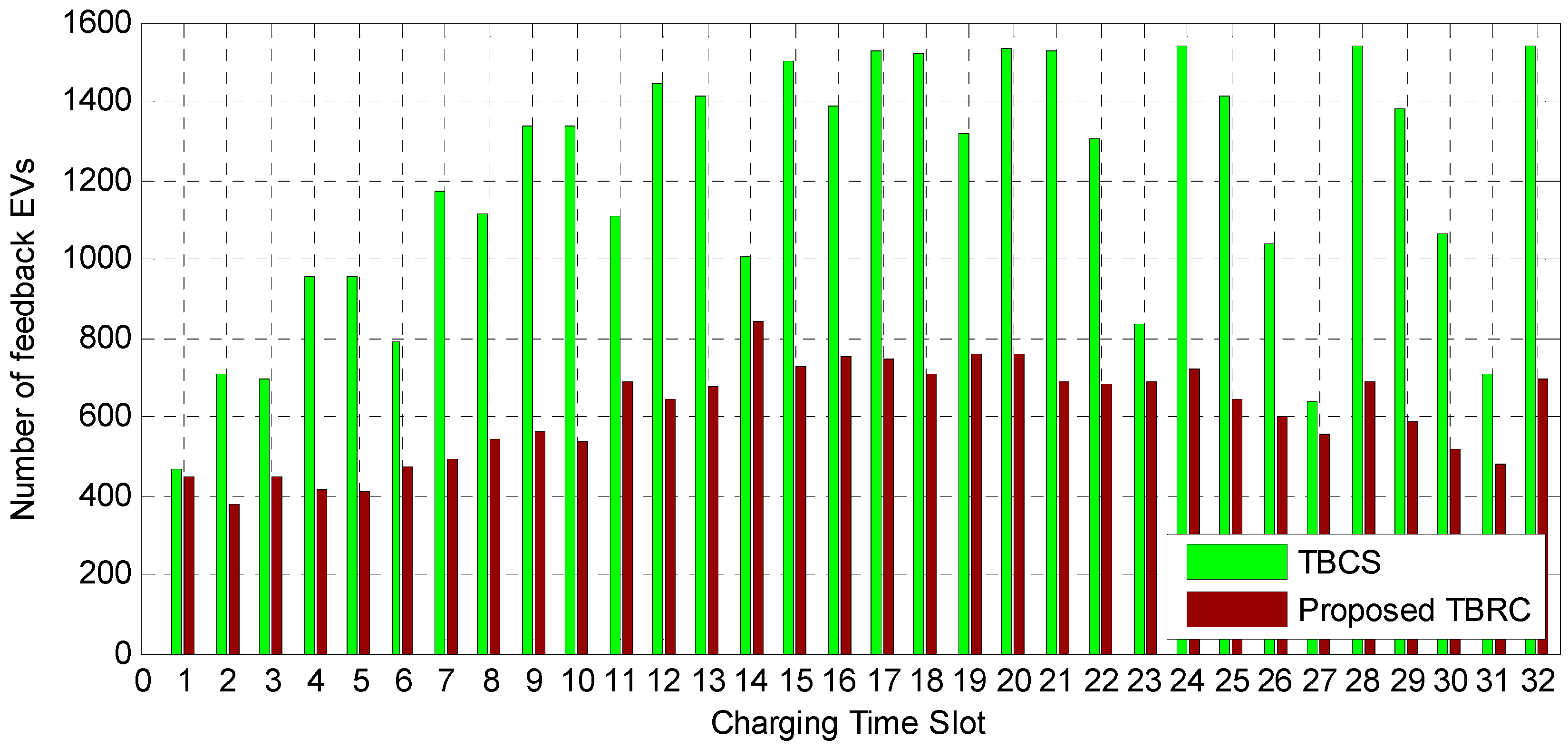1. Introduction
Due to environmental and sustainability concerns, the development and the commercialization of plug-in electric vehicles (PEVs) have attracted researchers during the last decade [
1,
2]. Nevertheless, the penetration of PEV charging systems in the conventional power distribution system may negatively affect the power distribution network in terms of voltage drops and power losses [
2,
3,
4]. Moreover, as the charging of the PEVs is uncoordinated in the existing power distribution network, the penetration of the PEVs will eventually become a burden for the conventional network [
5,
6]. To optimize the PEV charging system with coordination from a variety of perspectives, several studies have been performed to analyze the possible impacts on the power systems by the PEV charging loads [
7,
8,
9,
10,
11,
12,
13,
14,
15,
16]. The main objectives of those studies are the mitigation of the negative impacts by minimizing the increment of peak loads [
7,
8,
9], reducing the power losses [
10,
11], and minimizing the charging costs [
12,
13] or maximizing the discharging profits, i.e., vehicle-to-grid [
7,
14,
15,
16]. Therefore, most of the research done so far mainly focuses on the centralized optimization of the PEV charging system by stabilizing the power distribution system or by minimizing the charging costs. Recently, decentralized charging schemes have been considered to alleviate the computational complexity of a central controller [
17,
18,
19]. To decide the participation of PEV charging, these previous decentralized charging schemes also require that each customer points of charge (CPOC) should know real time information of all other CPOCs and the central controller, such as a battery state of charging (BSOC), voltage drops and power network constraints. However, communication networks to exchange the real time information among the CPOCs are hard to implement, because the real time information of all the CPOCs and the complexity of the central controller exponentially increase according to the increment of the PEVs in the PEV charging system. As the real time information increases, the cost of data transmissions increases and a complex communication infrastructure is required. For the practical implementation of the decentralized EV charging system, the decentralized charging system should exploit limited information, such as the information of the CPOC itself and statistical information of the power network constraints.
In wireless communication, a selective multiuser diversity (SMUD) scheme is proposed for attaining a reduction in the feedback overhead as well as for a multi-user diversity gain [
20,
21,
22,
23,
24,
25,
26]. In the SMUD scheme, users with a channel condition higher than a predetermined threshold, transmit their channel information to a base station, while the others do not transmit. The predetermined threshold is obtained by the average signal-to-noise ratio (SNR), which is related to the distance between the transmitter and receiver. The base station, then, prioritizes the requesters to allocate limited resources for data transmission. Thus, as a portion of users can participate in the requests for the data transmission to the base station, it is possible to reduce the participating users to require the data transmission compared to the conventional multiple user diversity schemes. Therefore, the SMUD can obtain a multi-user diversity and mitigate computational complexity of the central controller. For this reason, the SMUD is widely known as a distributed scheduling algorithm. According to the number of antennas, different types of fading channels and further feedback overhead mitigation, there have been several different types of SMUD. As the base station and mobile users had a single antenna, the threshold was determined by the normalized average SNR [
20]. In [
21,
22], the base station and the mobile users had multiple antennas. In addition, capacity analyses of systems with multiuser diversity for Rayleigh and Nakagami fading channels were researched [
23,
24]. To further mitigate the feedback overhead, the imperfect average SNR feedback schemes using one bit of information were addressed [
25,
26]. However, the characteristics of the average SNR for calculating the threshold differ from those of the BSOC in the PEV charging system.
In this paper, a threshold-based random charging scheme (TBRC) is proposed to reduce the number of PEVs participating in the charging requests to minimize the computation complexity of the central controller. As the number of charging requests by the PEVs increase, the handling of the computation complexity in the central controller deteriorates. Thus, only PEVs with a BSOC below the predetermined charging threshold transmit their charging requirements to the central controller, whereas other PEVs with a BSOC above the threshold do not send the charging requests. Because PEVs with a high BSOC cannot receive power for charging the PEVs owing to the power constraints of the distribution network, the charging requests for the PEVs with a high BSOC are dispensable. Therefore, the proposed threshold-based charging method can reduce the number of the charging required PEVs in the PEV charging network. However, most of the PEVs participate in the charging requests at the end of the charging period, because the concentration of the BSOCs in the PEV charging system gradually increases. This indicates that the number of PEVs with the same BSOC becomes larger towards the end of the charging period. Since the threshold is determined by quantizing the BSOC levels, the number of PEVs below the threshold increases cumulatively with the charging time, which causes a significant increase of control signaling overhead. To further mitigate the charging requests, a randomized charging scheme is also considered, which PEVs below the charging threshold can transmit their charging requests at a predetermined access rate. Both the PEV charging threshold and the random access rate are statistically determined by the average values of the supply power for charging the PEVs and the distribution of the initial BSOCs of the PEVs. Thus, the calculation of the thresholds and access rates do not need real time information exchange and updates among the CPOCs and between the target CPOC and the central controller. Therefore, the PEV can decide to participate in the charging request based on the statistical information of the PEV charging system. Further, the central controller finally determines the set of charging PEVs under the real time power network constraints for guaranteeing the system stability. The simulation results show that the proposed TBRC scheme accurately predicts the real profiles of the BSOC in the PEV charging system and reduces the overhead of the PEV charging requests.
3. Proposed Threshold-Based Charging Scheme Proposed Scheme
To reduce the number of the PEV charging participation and the control signal overhead in the centralized charging system, in this paper, an intelligent CPOC for the decentralized charging system is considered with a threshold-based random charging scheme (TBRC) which each PEV decides to participate in the PEV charging request.
Figure 2 displays the schematic diagram of the proposed TBRC according to the BSOC. There are 1540 PEVs in the PEV charging system [
16] and the distributions of all the PEVs with different BSOCs are shown. The dotted lines indicate the charging threshold value. PEVs with a current BSOC under the predetermined threshold will be charged as per the random access rate, whereas those above the threshold value will not be charged during this charging time-slot.
The predetermined threshold will increase according to the elapse charging time-slot because the average value of the BSOCs of all the PEVs increases owing to the supply power from the distribution network. Thus, the mean of the BSOCs increases, but the variance of the BSOCs decreases according to the elapse charging time-slot. Therefore, instead of the stochastic model, it is necessary to calculate the probability density function (pdf) of the BSOCs according to the charging time-slot by using
Table 1.
Table 1 shows the number of PEVs for each BSOC at the
t-th charging time-slot.
is the average number of PEVs in the
j-th level of the BSOC where
. From the pdf of the initial BSOCs,
-PEVs with in ascending order of the BSOC are charged under the supply power,
, according to the charging time-slot. Therefore,
is sequentially updated by the charged
-PEVs, and is not a real time changed value because
is a trend component of the supply power for charging the PEVs.
In this case,
is the highest charging level of the BSOC at the
t-th charging time slot, and therefore
represents the PEV charging threshold at the
t-th charging time slot. From (7),
is calculated by
where
Thus, Equations (14) and (15) comprise the average values from the statistical data of the PEV charging system and the trend component of the supply power. As the mean and variance of the BSOCs of all the PEVs in the PEV charging system are not changed instantaneously, each CPOC need not update the charging threshold value in accordance with the variations in the instantaneous demand power of the PEVs or the current number of PEVs with the same BSOC. In addition,
is also not real time changed, because
is dependent on the pdf of the initial BSOCs. Therefore, each CPOC can calculate the threshold by itself, based on the pdf of the BSOCs according to the charging time-slot before changing the statistical characteristics of the PEV charging system.
Table 2 shows a sample of the charging threshold according to the charging time-slot when
,
= 400,
k =
,
=
,
,
= 0.
However, in the threshold-based scheme, most of the PEVs participate in the transmission of their BSOC information to the central controller towards the end of the charging period. Because most of the PEVs have similar and high BSOCs owing to a sufficient power supply during the charging period, the concentrated distribution of the BSOCs of the PEVs provokes a significant increment in the requests for the PEV charging. To further mitigate the number of the PEV charging requests, the CPOC randomly participates in the charging request. To calculate the random access rate, the average number of PEVs below the predetermined threshold in the
t-th charging time-slot is represented by
From Equation (7), the average maximum number of PEVs served in
t-th charging time-slot is obtained as
. Thus, the random access rate is given as
Therefore, Equation (17) is also composed of the average values from the supply power for charging the PEVs.
To further improve the charging performance, the weight factor according to the difference between the current BSOC and the predetermined threshold is considered. Because PEVs with a low current BSOC have a high priority for the charging request to achieve fairness, PEVs that have a lower BSOC far from the charging threshold have a high probability for the charging request. As the
i-th CPOC knows both the current BSOC and the predetermined threshold, the random access rate of the
i-th CPOC is represented by
where
is a weight factor. By using Equations (14) and (18), the CPOC can decide to participate in the charging request to the central controller.
In the case of the central controller, after receiving the PEV charging requests from the CPOCs, , the central controller determines the -PEVs to be served by using an objective function. As , the optimal serving set composed of the PEVs that require charging is determined by Equation (13). However, as , all the -PEVs can charge at the same time, because is larger than .
Figure 3 describes the operational flow of the proposed TBRC scheme for a central controller and a CPOC. The central controller receives charging requests from the CPOCs having a BSOC lower than the charging threshold during every charging time-slot. If the demand power for charging requested by the PEVs is larger than the supply power, the central controller selects the charging PEVs under the limitations of the supply power, and then sends the permission and the power to the selected PEVs. As the current BSOC of the PEV is less than the charging threshold, the CPOC opportunistically transmits the charging request to the central controller by considering the predetermined random access rate of Equation (18). Further, the CPOC waits for receiving the permission and the supply power from the central controller. When it receives permission, the CPOC starts to charge the PEV and updates the current BSOC of the PEV. Periodically, the CPOC updates the charging threshold from the central controller after changing the statistical characteristics of the PEV charging system.
Through this process, the proposed TBRC can achieve the reduction of the PEV charging requests based on the decentralized algorithm in which the smart CPOCs individually decide to send the PEV charging request. Different from the conventional decentralized schemes [
17,
18,
19], in the proposed TBRC, the predetermined threshold and random access rate, which are the decision rules in the participation of the PEV charging request, are obtained by the statistical data such as the total number of the PEVs in the system, the mean and variance of the initial BSOCs of all the PEVs, and the average supply power for charging the PEVs. Therefore, the proposed TBRC does not need the exchange of real time information among the CPOCs and the central controller but long term update of the threshold and the access rate when the statistical characteristics of the PEV charging system may be varied according to seasonal changes. Furthermore, the reduction of the PEV charging requests means the diminution of the control signaling overhead among the CPOCs and the central controller.
4. Simulation Results
The objective of this simulation is to verify the impact of the proposed scheme on the charging performance and the reduction in the number of PEVs participating in the charging requests at the end of charging period. To manifest the benefits of the optimization technique, the synthetic data of the initial BSOCs is generated using different demand supply scenarios.
Table 3 shows the summary of the simulation environments.
4.1. Comparison of the Charging Performances of the SCSC and the Proposed Scheme
Figure 4 describes the supply power for charging the PEVs from Equation (2). Dotted line shows
in Equation (5), and solid line shows
that consists of real time supply power. In this simulation, both the threshold and the random access rate are calculated by the average supply power for charging the PEV,
, and the performance of the PEV charging system is simulated by
.
In
Figure 5, the overall trends of the BSOCs for the SCSC, the threshold-based charging scheme (TBCS), and the proposed threshold-based random charging scheme (TBRC) across the charging period are considerably close to each other. Hence, in the proposed TBRC and the TBCS schemes, the charging thresholds statistically determined by the average values of the supply power for charging the PEVs are proven to be appropriate. However, the charging performance of the proposed TBRC scheme at the end of charging period is lower than those of the other schemes because of the random access method.
In simulation case 1, (), all the PEVs that are plugged into the distribution network are almost fully charged (ranging from 17 to 20 kWh) at the end of the charging period for the SCSC. Meanwhile, in the proposed TBRC scheme, the distribution of the BSOCs of the PEVs is approximated to that of the SCSC but is slightly less than that of the SCSC. In the proposed TBRC scheme, 99.40% of the PEVs achieve a high BSOC ranging from 17 to 20 kWh and only 0.60% of the PEVs have a BSOC from 15 to 16 kWh.
In simulation case 2, (), all the PEVs cannot fully be charged because . Similar to simulation case 1, the overall charging performances of the TBCS and the proposed TBRC scheme are lower than that of the SCSC. However, 9.44% of the PEVs have a BSOC of 16 kWh, and only 0.29% of the PEVs are located on the range from 13 to 15 kWh. Actually, the simulation case 2 is not supposed to happen in the real power distribution system, but it is considered as the worst case for the power supply of the PEV charging system.
In simulation case 3, (), in the proposed TBRC scheme, 100% of the PEVs have their BSOCs within the range 17–20 kWh at the end of the charging session. The overall result is considered satisfactory for such a scenario. Therefore, irrespective of the simulation cases, the charging performances of the proposed charging schemes are lower than that of the SCSC, but the differences in the performances between the proposed schemes and the SCSC might be tolerable.
4.2. Comparison of the Control Signaling Overhead
Table 4 shows the comparison of the number of the PEVs participating in the charging requests for the SCSC, the TBCS, and the proposed TBRC scheme. In the proposed TBRC scheme, the average total number of the participated PEVs in charging, which sends the charging request to the central controller, decreases by 60.34%, 68.15%, and 51.56% for the three different scenarios compared to that of the SCSC, relatively, because in the proposed TBRC scheme only the PEVs having a BSOC below the predetermined threshold can participate in transmitting their charging requests at a predetermined random access rate to the central controller. Therefore, the simulation results demonstrate that the proposed scheme can reduce the participation of the PEV charging request and the control signaling overhead [
29].
Figure 6 displays the number of charging requests in the entire PEV charging system according to the charging time-slots. In the TBCS, the number of participating PEVs cumulatively increases, because the number of PEVs with the BSOC level near the threshold becomes larger towards the end of the charging period. Thus, the control signal overhead is proportionally increased by the charging requests of the PEVs. In addition, in the SCSC, all the PEVs send their BSOC information to the central controller. Therefore, in the proposed TBRC scheme, the number of PEVs participating in the charging requests is less than those of the SCSC and the TBCS.
5. Conclusions
In the coordinated PEV charging system, computational complexity of a central controller is significantly large enough to optimize the PEV charging system based on real time information of all PEVs and power network constraints. To resolve this problem, in this paper, a new threshold-based charging operation with a random access rate is proposed to minimize the number of PEVs participating in the transmission of the charging requests. To reduce the participation of the PEVs in the charging requests, only PEVs below the predetermined charging threshold can have the opportunity of transmitting their charging requirements at the predetermined access rate. Different from conventional decentralized schemes, both the charging threshold and the random access rate are statistically calculated based on average values of the supply power for charging the PEVs. Thus, the proposed TBRC does not share real time information among different CPOCs and a central controller, and needs to update the threshold and the access rate at long intervals.
In computer simulations, the proposed TBRC scheme was found to reduce the participation of the PEV charging requests up to 60.34% of that required in the coordinated PEV charging scheme, when the supply power is equal to or more than the demand power in the proposed TBRC scheme. In this case, the charging performance degradation of the proposed TBRC is negligible. Therefore, the proposed TBRC scheme has shown a substantial reduction in the control signaling overhead and a satisfactory performance of PEV charging system in the simulation cases.
For all simulation cases, we adopted a simple power distribution network with the least practical constraints to clearly demonstrate the difference between the present TBRC and the SCSC and also to avoid heavy computation. However, for the industrial and real-world applications of the proposed TBRC, it is firmly believed that the practical constraints of a distribution network (e.g., over/under voltage, feeder congestion, transformer capacity, and three-phase unbalance) need to be further considered.

